Sophia Antipolis / Côte d'Azur
Breath of fresh air
Despite being conceived in the 1960s, science-and-technology park Sophia Antipolis remains a green and pleasant blueprint for anyone wanting to do business and think big.
Ever on the lookout for novel ways to stimulate the knowledge economy, countries around the world are pouring billions of dollars into glittering new “smart cities”. The promise is that these hi-tech science parks will lure the brightest minds and kickstart the next Facebook or Google. But examples such as the newly built Innopolis in Kazan, Russia, or countless others across Asia, sit virtually empty and in varying states of completion. The reason is often simply that these cities do not feel like welcoming places to live and work, lacking the promise of life, beauty and diversions.
Investors in such projects would do well to pay a visit to France’s Sophia Antipolis. It might seem counter- intuitive to take cues from a science-and-technology park that’s almost 50 years old but the very fact that it has thrived for so long – when others can barely get off the ground – is evidence that it has wisdom to impart.
Europe’s first (and still its biggest) science-and-technology park is a sprawling mass of low-slung idiosyncratic buildings sitting unobtrusively among the swaying pines and eucalyptus trees in the hills above Cannes. Back in 1969 its founding father, Senator Pierre Laffitte, envisaged the park as a version of the bustling Latin Quarter in Paris; technology, the sciences, philosophy and the arts were to mix and mingle, stimulating minds and leading researchers, developers and academics to share ideas and transform them into industry.
“I thought it was necessary to develop a concentration of brains because the future of humanity depends much more on brains than infrastructure,” says Laffitte, who at 92 is still keeping a close eye on the place. Although his project had its fair share of detractors – “At the beginning everyone thought I was crazy,” he says – he successfully petitioned the national government for the allocation of land and funds for the endeavour.
For Laffitte, a geologist by training, the park was a very personal project: apart from meaning “wisdom” in Greek, Sophia was also the name of his first wife. Mapping out the masterplan himself, Laffitte’s aim was to respect the geology of the hills. The science park still retains a generous green belt around clusters of buildings, whose owners have pledged to look after their individual plots.
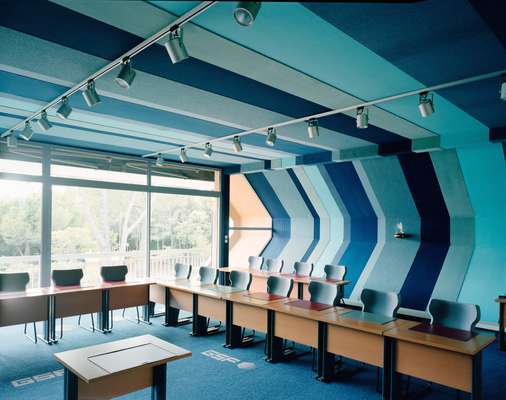
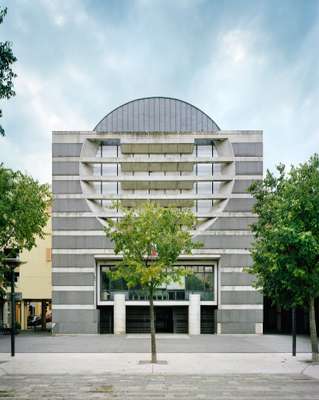
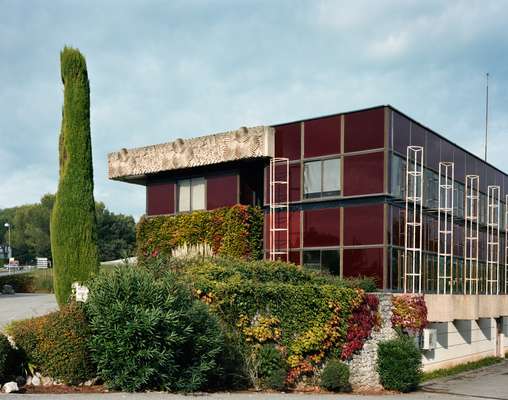
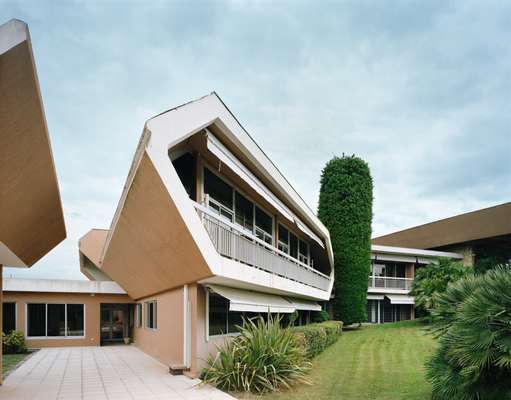
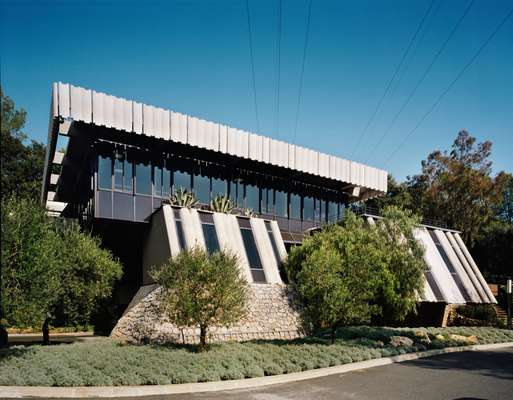
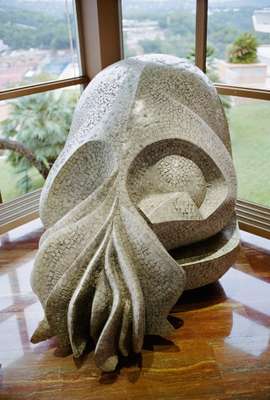
The urban plan seemed to follow “a direct line from Broadacre City, the anti-urban utopia designed by Frank Lloyd Wright in 1932 but without the [road] grid pattern”, says architect Richard Scoffier, who has written extensively on Sophia Antipolis. As in Lloyd Wright’s vision, the science park is not beholden to the pedestrian and here the car is king. Fences were discouraged, while building overwhelming high-rises that might block views to the ocean is forbidden to this day. “The message is a strong one: it’s sustainability and environmental protection, which 40 years ago was revolutionary,” says Philippe Mariani, CEO of the Sophia Antipolis Foundation.
As the idea for the park caught on, companies bought plots of land and invited architects to get creative within Laffitte’s vision. The repeating moulded façade panels of the Les Algorithmes building, for example, are reminiscent of the molecular structures studied within. Meanwhile gsf – France’s leading industrial cleaning company – built an outlandish, futuristic cornucopia of hexagonal patterns and bold colours in 1978 as a symbol of the brand’s confidence in the world Laffitte was creating. But not disturbing the landscape was key: walking between buildings might take visitors through a grove of pines, down an unpaved path, while the striking postmodernist structures follow the curves and bends of the terrain and on occasion almost disappear into the forests that surround them.
Today the buildings shelter close to 35,000 engineers, developers, academics, scientists, researchers and students who toil in the fields of computing, electronics and biotechnology. International brands such as Toyota and a host of home-grown outfits including divisions of Air France, Orange and Chanel have found a home, as well as Mines ParisTech – an extension of the Paris-based engineering school – and a branch of the University of Nice. All in all, 1,350 companies now have a presence here and the park’s annual turnover of €3.5bn is a sizeable contribution to France’s third-wealthiest region, which otherwise gets the majority of its income from seasonal tourism.
Although some companies guard their r&d secrets closely, one key to the park’s success lies in its stimulation of cross-pollination. The Sophia Antipolis Foundation, for example, holds networking events where researchers, start-ups and angel investors meet to exchange ideas, recruit new talent and attract funding. Then there’s the park’s diverse community and recent refocusing on start-ups, which means that Sophia Antipolis has been able to weather crises such as the bursting of the dotcom and telecom bubbles. Businesses can fail and be reborn in a space that offers a strong support network. “There is an established ecosystem of funding and bright people so start-ups will always find a market here,” says Mariani.
Attracting talent, nurturing new businesses and encouraging gifted students are the park’s most pressing challenges. Sophia Antipolis stalwart Jean-François Carrasco – who in a black velvet jacket and thick-rimmed glasses looks more like an artist than a project director of Mentis Services, a software-engineering company – works with Telecom Valley, a cluster of digital businesses. It acts as a bridge between academics and companies in order to promote entrepreneurship among students. “Today we have dozens of people who can earn a living simply because we have helped a former student set up his own company,” he says. “If people want something to happen we will help them; it’s very empowering and rewarding.”
Although entrepreneurial Antipolitans say they are drawn to the park because of its parallels with Silicon Valley, Sophia Antipolis is still to foster a start-up on anything like the scale of the West Coast’s big hitters. Attracting adequate venture-capital funding and convincing investors to be less risk-averse are ongoing challenges, as they are across the rest of Europe. Sluggish growth within the EU in recent years hasn’t helped either.
Laffitte himself admits that it has been tricky to sustain his ambitious vision for Sophia. Apart from a few early concerts and some stabs at public statues, the park has not delivered on its cultural and artistic promise. Meanwhile its urban plan, which has dispensed with a discernible centre, means the park lacks a focal point and has few public places where people can come together to socialise. Following Lloyd Wright’s example has meant a reliance on cars, which frustrates some people’s 21st-century preference to get about on foot or two wheels.
Yet Sophia Antipolis still offers many lessons for those keen to establish a science-and-technology park that’s built to last and remain occupied – and one of its most evident advantages is its location. Nice Airport, France’s third-busiest, is on its doorstep and all the pleasures of the French Riviera are a short car journey away. Being in a nature reserve is also a plus. “The beautiful forests around us make us feel much more comfortable and less stressed than we might do in a big city,” says Carrasco. “If you’re stuck for an idea you can go for a walk or a jog around the park and be back at your desk with new inspiration.”
The park’s architecture, which respects its natural surroundings and eschews alienating glass-and-steel towers, helps to nurture a sense of wellbeing and has fostered a genuine community. “It’s a little like a holiday village: everyone knows each other,” says Carrasco. That helps in creating an attractive business environment too. “It’s more organic and flexible,” says Christophe Imbert, CEO of travel data-gathering start-up Milanamos. “Not like what happens in other parks, where everything is too structured and organised.”
And this is perhaps the key to the success of Sophia Antipolis: unlike in other recently designed technology cities, you don’t feel like you’re walking around an architect’s outsized, sterile model. It may have fallen short on some of its grand utopian ambitions – and it may not have delivered France its equivalent of Google’s HQ – but it has managed to organically evolve into a vibrant community of 35,000 inhabitants. As Carrasco puts it, “Sophia Antipolis is an answer – it’s not the answer but it’s one of the nicest I know.”
Notes: how to build a business park
For any city hall or municipality considering creating a commercial campus, Sophia Antipolis is an example to follow and reveals pitfalls to avoid. Here are some key lessons.
- Built environment: Don’t get carried away with glazed façades. They may feel “futuristic” but nobody actually wants to work or live in a glass box.
- Location: Avoid Siberia and plump for a plot in a warm climate, preferably near the sea.
- Sense of community: Fostering a community takes time but that’s how you ensure longevity. Nurture the business ecosystem, yes, but don’t neglect the need for some social interaction.
- Culture: One of Sophia Antipolis’s ambitions was to foster an artistic community – but it fell short. New developments should take up the challenge and invest in public artwork.
- Transport infrastructure: As the car is no longer king, make sure there is adequate public transport.


